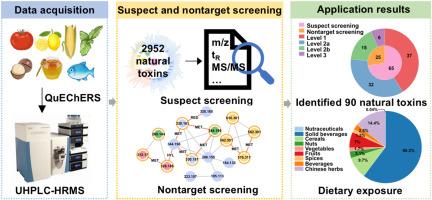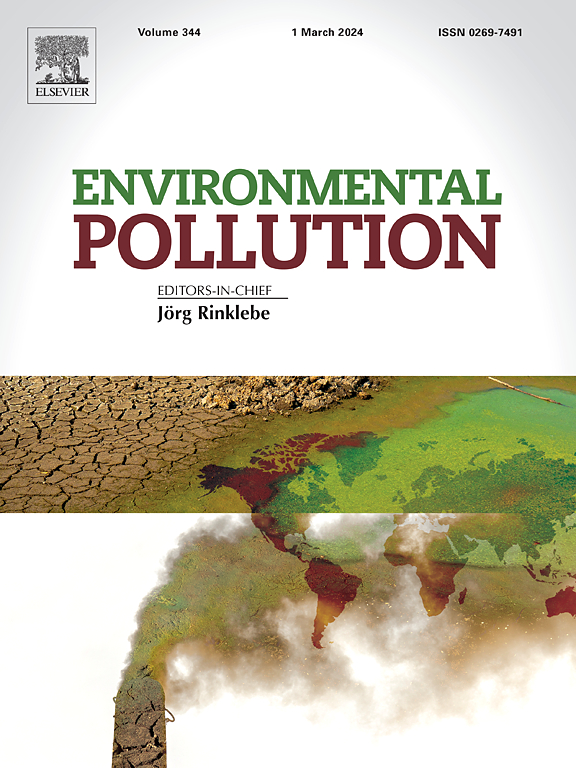基于高分辨率质谱的食品中天然毒素的可疑和非目标筛选以及膳食暴露风险评估
IF 7.6
2区 环境科学与生态学
Q1 ENVIRONMENTAL SCIENCES
引用次数: 0
摘要
日常饮食摄入不可避免地会让人接触到各种天然毒素,这些毒素可能会对健康造成潜在威胁。只关注特定毒素可能会低估膳食风险。因此,我们开发了一种基于超高效液相色谱-高分辨质谱(UHPLC-HRMS)的疑似和非目标方法,用于筛查各种食品中已知和未知的天然毒素。该方法建立了一个包含 2952 种天然毒素(包括真菌毒素、植物毒素、动物毒素和蓝藻毒素)的内部数据库,为筛选疑似毒素提供了便利。预测保留时间和质谱数据被用来提高置信度。随后,基于分子网络分析进行了非目标筛选方法,通过修饰类型和碎片特征标注了边缘和节点。最后,我们分析了 102 份食品样本,共鉴定出 90 种天然毒素,包括霉菌毒素和植物毒素,其中 65 种是通过可疑筛选鉴定的,25 种是通过非目标筛选鉴定的。根据测得的浓度,估算出了天然毒素的人均日膳食摄入量,该摄入量低于现有参考值中天然毒素的风险剂量。总之,这项工作建立了一种全面鉴定食品中天然毒素的新方法,并强调了天然毒素膳食风险评估的重要性。本文章由计算机程序翻译,如有差异,请以英文原文为准。

High-resolution mass spectrometry-based suspect and nontarget screening of natural toxins in foodstuffs and risk assessment of dietary exposure
Daily dietary intake inevitably exposes individuals to various natural toxins, which may pose potential health threats. Focusing only on specific toxins could underestimate dietary risks. Therefore, we have developed a suspect and nontarget method based on ultrahigh-performance liquid chromatography-high resolution mass spectrometry (UHPLC-HRMS) to screen both known and unknown natural toxins in various foodstuffs. An in-house database containing 2952 natural toxins including fungal toxins, phytotoxins, animal toxins and cyanotoxins was established, facilitating suspect screening. Predicted retention time and mass spectrometry data were employed to enhance the confidence levels. Subsequently, Nontarget screening method was conducted based on molecular network analysis, annotating the edges and nodes through modified types and fragmentation characteristics. Finally, we analyzed 102 foodstuff samples and identified a total of 90 natural toxins, including mycotoxins and phytotoxins, with 65 identified by suspect screening and 25 by nontarget screening. Based on measured concentrations, the daily per capita dietary intake of total natural toxins was estimated, it was below risk doses for natural toxins with available reference values. Overall, this work established a novel method for the comprehensive identification of natural toxins in foodstuffs and emphasized the importance of dietary risk assessment for natural toxins.
求助全文
通过发布文献求助,成功后即可免费获取论文全文。
去求助
来源期刊

Environmental Pollution
环境科学-环境科学
CiteScore
16.00
自引率
6.70%
发文量
2082
审稿时长
2.9 months
期刊介绍:
Environmental Pollution is an international peer-reviewed journal that publishes high-quality research papers and review articles covering all aspects of environmental pollution and its impacts on ecosystems and human health.
Subject areas include, but are not limited to:
• Sources and occurrences of pollutants that are clearly defined and measured in environmental compartments, food and food-related items, and human bodies;
• Interlinks between contaminant exposure and biological, ecological, and human health effects, including those of climate change;
• Contaminants of emerging concerns (including but not limited to antibiotic resistant microorganisms or genes, microplastics/nanoplastics, electronic wastes, light, and noise) and/or their biological, ecological, or human health effects;
• Laboratory and field studies on the remediation/mitigation of environmental pollution via new techniques and with clear links to biological, ecological, or human health effects;
• Modeling of pollution processes, patterns, or trends that is of clear environmental and/or human health interest;
• New techniques that measure and examine environmental occurrences, transport, behavior, and effects of pollutants within the environment or the laboratory, provided that they can be clearly used to address problems within regional or global environmental compartments.
 求助内容:
求助内容: 应助结果提醒方式:
应助结果提醒方式:


